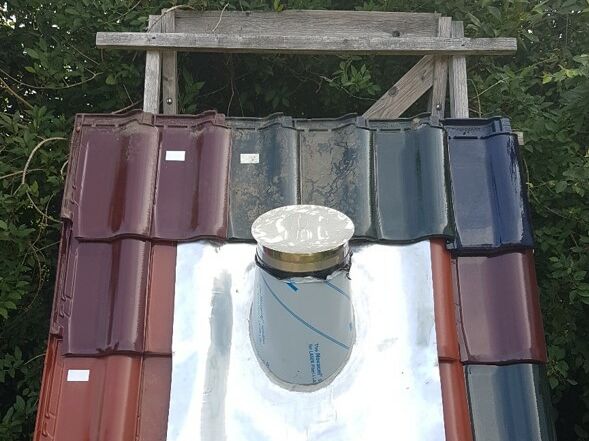Lead sheets are mainly used to seal transitions of complex geometry in the roof and façade area. Examples of such transitions are wall junctions, skylight surrounds or supports for roof penetrations for chimney systems. Rolled lead is particularly easy to form and thus enables simple, form-fitting adaptation to the individual roof geometry. The lead supports are usually connected to each other or to other metallic construction elements by soldered joints.
The use of conventional lead elements is controversial worldwide due to the high toxicity of the heavy metal. In Scandinavia in particular, the use of this material for waterproofing work is therefore already prohibited by law. In the future, it can be assumed that other nations will follow the Scandinavian example and also impose a lead ban. In addition, creating a tight and visually appealing solder joint between lead and other metals is relatively complicated. Another disadvantage is the comparatively very high weight of lead, which makes professional installation even more difficult.
The objective of the R&D project is to develop an innovative lead-free composite sealing material for multi-curved planes. This is a high-quality alternative that is in no way inferior to conventional lead sheets in terms of mechanical properties, appearance and ageing resistance, but is absolutely free of components that are harmful to health and the environment. The novel material is to be available both as roll material for individual sealing work and as a defined prefabricated part for the roof penetration of various modules. In addition to sealing transitions, it is also conceivable that it could be used as a large-area roofing material for roofs and façades.
Overview of the main characteristics of the sealing material to be developed:
- intended use: sealing of transitions of predominantly complex geometry in the roof and façade area (if necessary, large-area covering of roofs or façades).
- no ingredients that are harmful to health or the environment (recyclable if possible)
- design as metal-polymer composite
- easy to shape by hand, permanent shape retention
- permanent tightness
- high resistance to ageing and corrosion (target service life of approx. 30 years)
- good weather resistance (under UV radiation, rain/hail, extreme temperatures, etc.)
- high tear resistance
- good stretchability with low elastic recoil
- metallic surface with a high-quality appearance
- low weight and lowest possible production costs
The aim is to develop a composite sealing material that meets the above requirements under all possible climatic and design boundary conditions.
While the joint partner, Torgelower Metallwaren GmbH, contributes knowledge and experience from its own product range to the project, KBauMV, as the scientific institution of Wismar University of Applied Sciences, can contribute important theoretical findings. This applies in particular to the fundamentals of building materials, building physics and construction, which are necessary for the evaluation of possible applications and durability of the innovative product. The necessary mechanical and building physics tests are to be carried out with an appropriately well-equipped pool of equipment.
